Doctors treated hundreds of heatstroke victims in hospitals across Pakistan on Thursday after a severe heatwave caused by climate change sent temperatures above normal, officials said.
The previous day, temperatures soared to 49 degrees Celsius (120 degrees Fahrenheit) in Mohenjodaro. The city, known for its ruins, is located in the southern province of Sindh, which was hit hard by climate-induced monsoon rains and devastating floods in 2022. The heatwave is expected to last for at least a week.
Authorities are urging people to stay indoors, stay hydrated and avoid unnecessary travel. But workers say they have no choice because they have to work to support their families.
“Pakistan is the fifth most vulnerable country to the impacts of climate change. We are witnessing above-normal rains and floods,” Rubina Khurshid Alam, climate coordinator to the prime minister, told a press conference in the capital, Islamabad.
Civil Defense official Balakullah Khan urged the public not to leave cooking gas cylinders outdoors as a safety measure. He also warned people living near fields that snakes and scorpions could enter homes and warehouses in search of a cool place.
Forecasters say temperatures could soar to as high as 55 degrees (131 degrees) this month.
Doctors said they treated hundreds of patients in the eastern city of Lahore, while dozens were taken to hospitals in the southern Sindh provinces of Hyderabad, Larkana and Jacobabad.
“The situation has worsened since yesterday as people suffering from the heat started being rushed to hospitals in Punjab,” said Ghulam Farid, a senior health official. Pakistan has set up emergency response centers in hospitals to treat patients suffering from the heat.
Health officials say the state-run ambulance service is currently carrying bottled water and ice to provide first aid to heat victims.
The United Nations Children’s Fund called for protection of children from the heat.
“UNICEF is deeply concerned about the health and safety of infants and young children as debilitating heatwaves prevail in several countries,” said Sanjay Wijesekera, UNICEF Regional Director for South Asia. He said rising temperatures across the region could put the health of millions of children at risk if they are not protected and hydrated. .
Heatstroke is a serious illness caused by a sudden rise in body temperature, which can lead to loss of consciousness. Severe heatstroke can cause disability and death.
This year, Pakistan recorded its wettest April since 1961, with more than double the normal monthly rainfall. Last month’s heavy rains left many dead and destroyed homes and farmland.
Daytime temperatures are up to 8 degrees Celsius (46 degrees Fahrenheit) higher than in May, raising concerns about flooding in the Northwest due to melting glaciers.
The 2022 floods caused severe damage in Sindh and Baluchistan provinces and killed 1,739 people across the country.
Currently, a heatwave is also occurring in the southwest and northwest of Pakistan.
Authorities closed schools in Punjab for a week. In Lahore, people were seen swimming in roadside canals. Pakistan says it is bearing the brunt of the global climate disaster despite accounting for less than 1% of carbon emissions.
Alam said the recent unusual changes in weather patterns are a result of human-made climate change.
___
Munir Ahmed The Associated Press
Associated Press writer Babar Dogar contributed to this article from Lahore, Pakistan.

